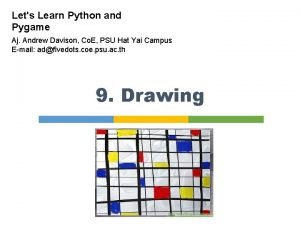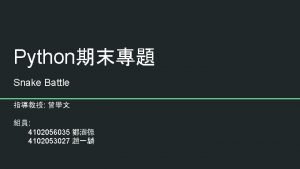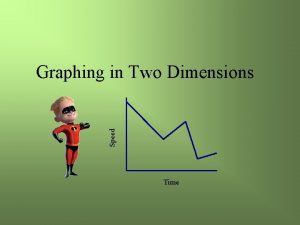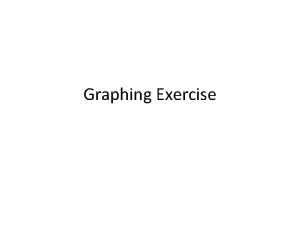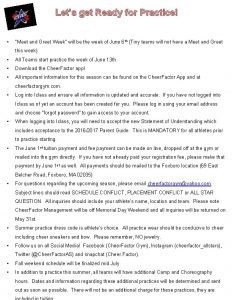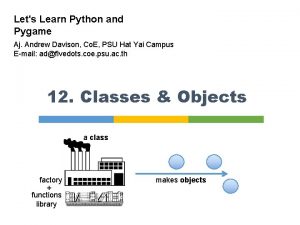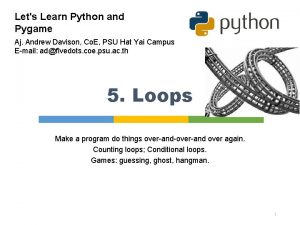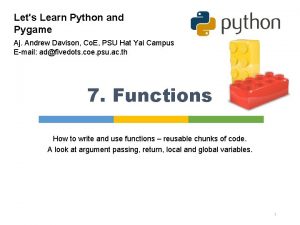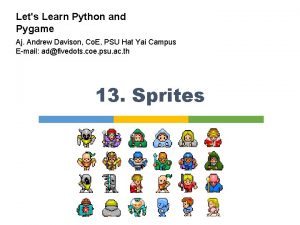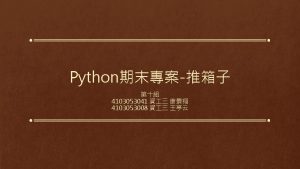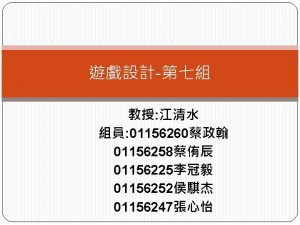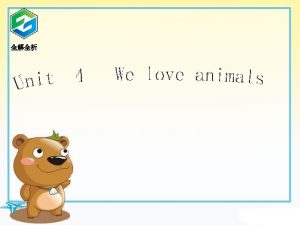Lets Learn Python and Pygame Aj Andrew Davison













![When has the ball left the screen? if pos[1] > scr. Height-1: pos = When has the ball left the screen? if pos[1] > scr. Height-1: pos =](https://slidetodoc.com/presentation_image_h2/d915e4c841a73703d9db2ac6355ecdaf/image-14.jpg)






![Code: beach. Bounce. py pygame. init() screen = pygame. display. set_mode([640, 480]) screen. fill(WHITE) Code: beach. Bounce. py pygame. init() screen = pygame. display. set_mode([640, 480]) screen. fill(WHITE)](https://slidetodoc.com/presentation_image_h2/d915e4c841a73703d9db2ac6355ecdaf/image-21.jpg)



- Slides: 24

Let's Learn Python and Pygame Aj. Andrew Davison, Co. E, PSU Hat Yai Campus E-mail: ad@fivedots. coe. psu. ac. th 11. Animation

Outline 1. 2. 3. 4. 5. 6. Basic Game Loop Again Animation Loop for a Ball Animation 1 Ball Animation 2 Multiple Balls Falling Bouncing Ball 2

1. Basic Game Loop Again pygame. init() screen = pygame. display. set_mode((640, 480)) screen. fill((255, 255)) pygame. display. set_caption("Game") clock = pygame. time. Clock() running = True while running: # game loop clock. tick(30) # handle events for event in pygame. event. get(): if event. type == QUIT: running = False handle events update game # update game redraw game # redraw game pygame. display. update() pygame. quit() 3

2. Animation Loop for a Ball # setup Pygame window as on last slide # load ball as image # initialize ball's (x, y) position # initialize ball's step (x. Step, y. Step) done in each loop clock = pygame. time. Clock() running = True while running: # game loop clock. tick(30) # handle events for event in pygame. event. get(): if event. type == QUIT: running = False # update game x += x. Step; y += y. Step # redraw game # draw image at (x, y) pygame. display. update() pygame. quit() (x, y) x. Step y. Step 4

3. Ball Animation 1 §The ball starts at a random position along the top, and then drops downwards forever. § the ball's position is printed in the command prompt window 5

Code: anim. Ball-1. py pygame. init() screen = pygame. display. set_mode((400, 400)) pygame. display. set_caption("Ball Animation") # load ball as image ball. Im = pygame. image. load('small. Ball. png'). convert_alpha() # store dimensions for later scr. Width, scr. Height = screen. get_size() im. Width, im. Height = ball. Im. get_size() # initialize ball's position x = random. randrange(0, scr. Width-1 - im. Width) y = 0 screen. blit(ball. Im, [x, y]) # initialize ball's step done in each loop x. Step = 0; y. Step = 8 clock = pygame. time. Clock() : 6

running = True while running: clock. tick(30) # handle events for event in pygame. event. get(): if event. type == QUIT: running = False # update game state # Move ball down y += y. Step print("Pos: ", x, y) # redraw screen. fill(BLACK) screen. blit(ball. Im, [x, y]) pygame. display. update() pygame. quit() 7

Setting the Ball's Start Position x = random. randrange(0, scr. Width-1 - im. Width) y = 0 screen. blit(ball. Im, [x, y]) scr. Width im. Width ( scr. Width-1, 0) (0, 0) im. Width (x, y) range of x for the ball 8

Where's the Ball? §The problem is that the ball keeps moving downwards forever, even after it has dropped below the bottom of the screen (y == 480). 9

4. Ball Animation 2 §When the ball drops off the bottom of the screen, it's (x, y) position is reset to be at a random place along the top. then starts at the top again 10

Code: anim. Ball-2. py screen = pygame. display. set_mode((400, 400)) pygame. display. set_caption("Ball Animation") # load ball as image ball. Im = pygame. image. load('small. Ball. png'). convert_alpha() # store dimensions for later scr. Width, scr. Height = screen. get_size() im. Width, im. Height = ball. Im. get_size() # initialize ball's position pos = random. Pos() # pos is the list [x, y] # screen. blit(ball. Im, pos) # not needed usually # initialize ball's step done in each loop x. Step = 0; y. Step = 8 clock = pygame. time. Clock() : 11

running = True while running: clock. tick(30) # handle events for event in pygame. event. get(): if event. type == QUIT: running = False # update game state # if ball has exited bottom if pos[1] > scr. Height-1: pos = random. Pos() # Move ball down pos[1] += y. Step # print("Pos: ", pos) # redraw screen. fill(BLACK) screen. blit(ball. Im, pos) pygame. display. update() pygame. quit() 12

random. Pos() def random. Pos(): # create a random position # x position somewhere along top x = random. randrange(0, scr. Width-1 - im. Width) y = 0 return [x, y] 13
![When has the ball left the screen if pos1 scr Height1 pos When has the ball left the screen? if pos[1] > scr. Height-1: pos =](https://slidetodoc.com/presentation_image_h2/d915e4c841a73703d9db2ac6355ecdaf/image-14.jpg)
When has the ball left the screen? if pos[1] > scr. Height-1: pos = random. Pos() (0, 0) scr. Height (0, scr. Height-1) (x, y) 14

5. Multiple Balls Falling §Have 30 balls falling, and reappearing back at the top in random new positions. § Only one image is needed, but a list of 30 (x, y) positions. then starts at the top again 15

Code: anim. Balls. py pygame. init() screen = pygame. display. set_mode((400, 400)) pygame. display. set_caption("Balls Animation") # load ball as image ball. Im = pygame. image. load('small. Ball. png'). convert_alpha() # store dimensions for later scr. Width, scr. Height = screen. get_size() im. Width, im. Height = ball. Im. get_size() # initialize many random positions pos. List = [] for i in range(30): pos. List. append(random. Pos()) The list is a list of [x, y] values, one for each ball: [ [x 0, y 0], [x 1, y 1], …. ] # initialize ball's step done in each loop x. Step = 0; y. Step = 8 clock = pygame. time. Clock() : 16

running = True while running: clock. tick(30) # handle events for event in pygame. event. get(): if event. type == QUIT: running = False # update game state for i in range(len(pos. List)): # if ball has exited bottom if pos. List[i][1] > scr. Height-1: pos. List[i] = random. Pos() # Move ball down pos. List[i][1] += y. Step # redraw screen. fill(BLACK) for i in range(len(pos. List)): # draw a ball at each position screen. blit(ball. Im, pos. List[i]) pygame. display. update() pygame. quit() The position of the ith ball (x, y) is stored in pos. List[i][0] == x pos. List[i][1] == y 17

Revised random. Pos() def random. Pos(): # create a random position # x position somewhere along top x = random. randrange(0, scr. Width -1 - im. Width) # y position above the top y = random. randrange(-scr. Height, 0) return [x, y] scr. Width -scr. Height - 1 - im. Width position a ball anywhere in this area (0, 0) 18

6. Bouncing Ball §Have a single ball bounce off the 'walls' of the screen. 19

Bouncing Ball Coords 20
![Code beach Bounce py pygame init screen pygame display setmode640 480 screen fillWHITE Code: beach. Bounce. py pygame. init() screen = pygame. display. set_mode([640, 480]) screen. fill(WHITE)](https://slidetodoc.com/presentation_image_h2/d915e4c841a73703d9db2ac6355ecdaf/image-21.jpg)
Code: beach. Bounce. py pygame. init() screen = pygame. display. set_mode([640, 480]) screen. fill(WHITE) pygame. display. set_caption("Bouncing Beachball") ball. Im = pygame. image. load('ball. png'). convert_alpha() # store dimensions for later scr. Width, scr. Height = screen. get_size() im. Width, im. Height = ball. Im. get_size() # start position of the ball x = 50; y = 50 # step size and direction along each axis x. Step = 10; y. Step = 10 clock = pygame. time. Clock() : 21

running = True while running: clock. tick(30) # handle events for event in pygame. event. get(): if event. type == QUIT: running = False # update game state # change x-step direction at left and right sides if (x <= 0) or (x >= scr. Width - 1 - im. Width): x. Step = -x. Step # change y-step direction at top and bottom sides if (y <= 0) or (y >= scr. Height -1 - im. Height): y. Step = -y. Step x += x. Step y += y. Step # move the ball horizontally # and vertically # redraw screen. fill(WHITE) screen. blit(ball. Im, [x, y]) pygame. display. update() pygame. quit() 22

x- Direction Change §The x- direction depends on if x. Step is positive or negative. § the direction is changed by swapping +/§ x. Step = -x. Step §It should change when the ball tries to leaves the screen on the left side or on the right side. (0, y) (x, y) x <= 0 X (scr. Width-1, y) (x, y) x >= scr. Width-1 im. Width X 23

y- Direction Change §The y- direction depends on if y. Step is positive or negative. § the direction is changed by swapping +/§ y. Step = -y. Step §It should change when the ball tries to leaves the screen on the top or bottom. (x, 0) (scr. Height-1, 0) (x, y) y <= 0 (x, y) y >= scr. Height-1 im. Height X X 24
 Lets learn python
Lets learn python Lets go learn.com
Lets go learn.com Arthur davison
Arthur davison Dolores davison
Dolores davison Galvez davison index
Galvez davison index Dolores davison
Dolores davison Angela davison
Angela davison Eal nexus
Eal nexus Keith davison
Keith davison Revision techniques for kinesthetic learners
Revision techniques for kinesthetic learners Pygame blit text
Pygame blit text Pygame antialiasing
Pygame antialiasing Pygame coordinates
Pygame coordinates Sprite outline
Sprite outline Pygame basics
Pygame basics Pygame custom font
Pygame custom font Pygame sound effects
Pygame sound effects Pygame
Pygame Agent snake game
Agent snake game Pygame antialiased line
Pygame antialiased line Lets just kiss and say goodbye
Lets just kiss and say goodbye A train pulls into a station and lets off its passengers
A train pulls into a station and lets off its passengers Qualitative graph definition
Qualitative graph definition Lets meet and greet
Lets meet and greet Bbc bitesize tissue poem
Bbc bitesize tissue poem















